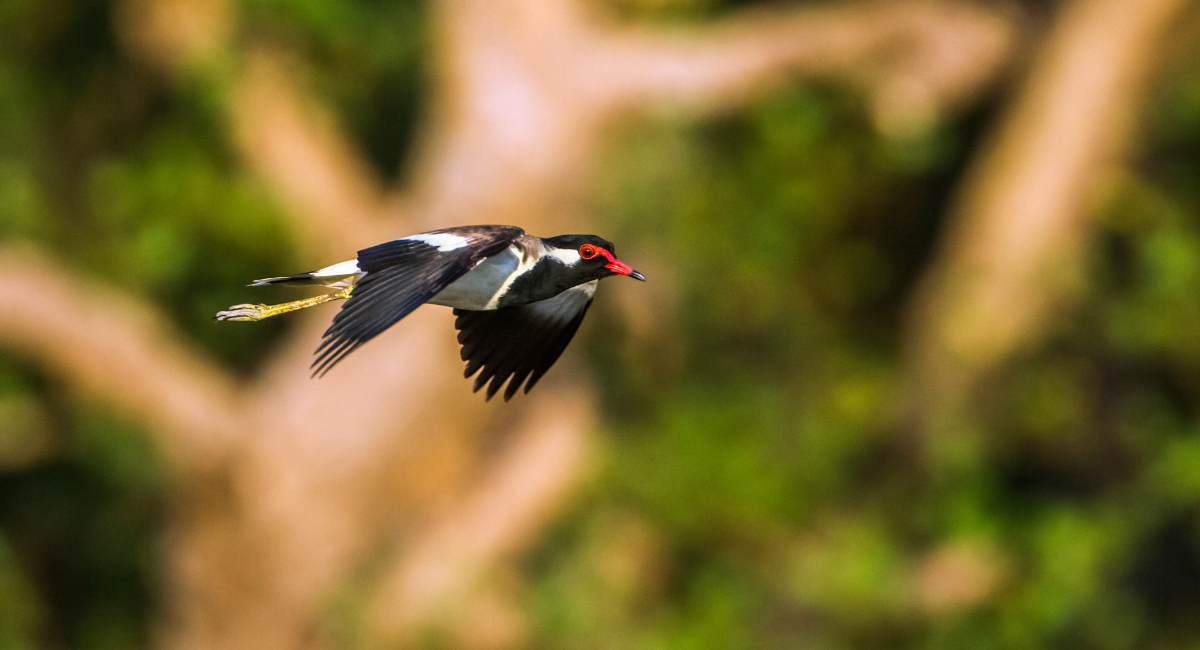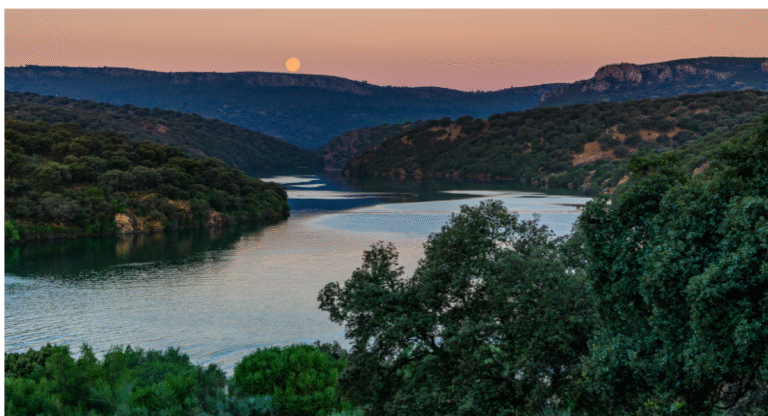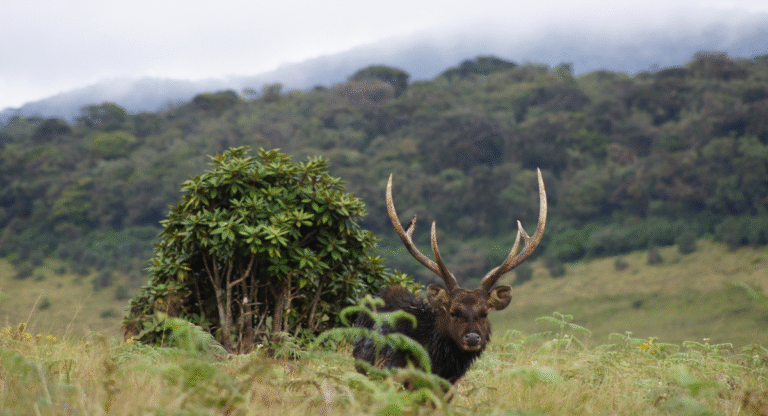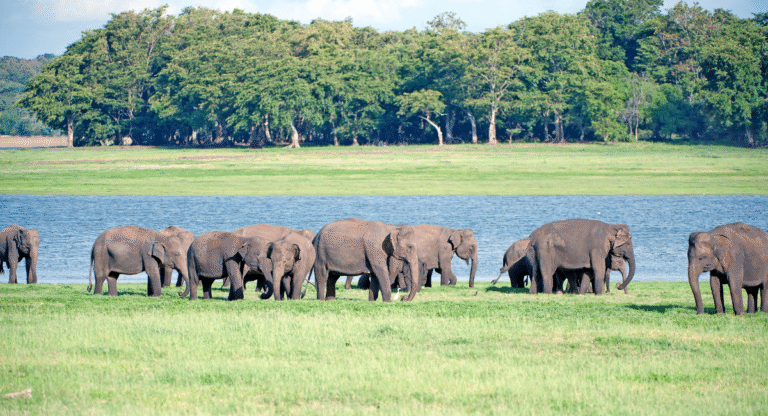Introduction: Bundala – The Quiet Giant of Sri Lankan Conservation
For the dedicated ecotourist or the serious ornithologist, Sri Lanka offers a dazzling array of biodiversity. While names like Yala National Park draw global attention for their high-density mammal sightings, Bundala National Park stands apart, commanding respect not through sheer animal size but through ecological significance and global conservation standing. Bundala is, without question, the island’s most important wetland for birding, offering an intimate, high-quality experience distinctly different from the high-traffic parks that define mass safari tourism.
Located approximately 252 kilometers southeast of the capital city, Colombo, in the dry, arid zone of the Hambantota District , Bundala is an ecologically diverse haven spanning roughly 6,000 hectares. Its geography is a mosaic of habitats: coastal dunes, brackish lagoons, intertidal mudflats, freshwater ponds, and dry thorny scrubland, all of which combine to support an incredible wealth of life.
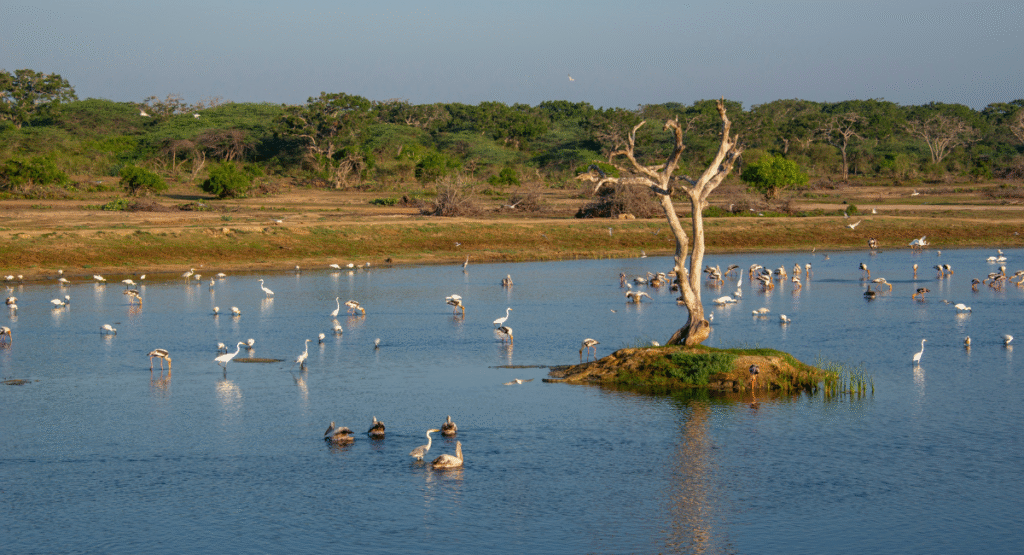
Bundala’s Global Conservation Credentials – The Triple Crown Status
What elevates Bundala far above a standard wildlife destination is its exceptional conservation status, a rare achievement that underscores its essential global role. Bundala has earned what can be considered the Triple Crown of Sri Lankan conservation designations:
- Wildlife Sanctuary and National Park: The area was initially protected as a Wildlife Sanctuary in 1969. Following further recognition of its critical ecological value, it was upgraded and designated a full National Park on 4 January 1993.
- Sri Lanka’s First Ramsar Wetland: In 1991, Bundala secured the monumental distinction of becoming the first wetland in Sri Lanka to be declared a Ramsar site. This designation, given by the Convention on Wetlands of International Importance, acknowledges Bundala’s critical role as an internationally important habitat, specifically for migratory waterfowl. This status confirms that visiting Bundala is not merely a safari, but an encounter with a globally protected ecosystem.
- UNESCO Biosphere Reserve: Further solidifying its importance, Bundala was designated a UNESCO Biosphere Reserve in 2005, making it the fourth such reserve in the country. This layered recognition—from local sanctuary to international reserve—places it at the forefront of global conservation efforts, emphasizing the necessity of regulated, low-impact tourism.
The ecological complexities inherent in maintaining a wetland of international importance are profound. For instance, the park’s four main lagoons—Bundala, Embilikala, Malala, and Koholankala—do not behave identically. Research has shown that brackish-water-adapted species, most notably the Greater Flamingo, utilize the unaffected Bundala lagoon to a far greater extent than the irrigation-affected Malala and Embilikala lagoons. This differential use illustrates the immediate, tangible impact of upstream freshwater diversion on the health of the globally recognized site. Therefore, visiting Bundala is an exercise in ecological awareness, supporting conservation efforts aimed at protecting these fragile, interdependent wetland components against external pressures.
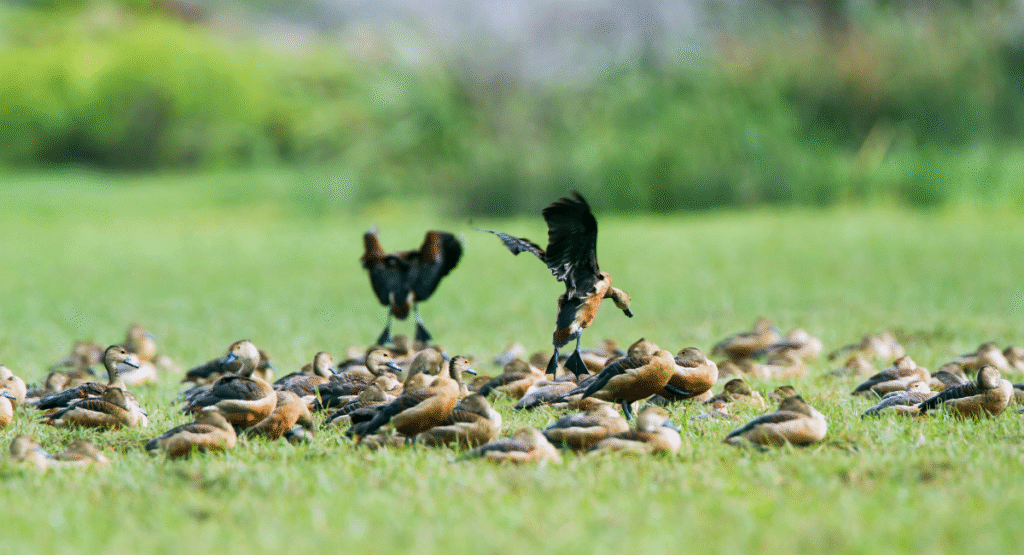
The Avian Spectacle: Tracking Migration and Finding the Flamingos
Bundala National Park is Sri Lanka’s final destination on a vast global migration highway. Its geographical position, situated just south of the Indian subcontinent, places it directly in the path of waterfowl travelling enormous distances, with some individuals journeying from as far north as Siberia. This strategic location makes it an indispensable wintering ground.
Diversity in Numbers and the Flagship Species
The park is an avian powerhouse, harboring an incredible diversity of birdlife, with close to 200 species identified. Of this population, 58 species are classified as migratory, ensuring a constantly evolving spectacle throughout the winter months. These figures confirm that Bundala provides rich and varied viewing opportunities that appeal to both general enthusiasts and specialized birders.
The unrivaled highlight of a Bundala safari is the Greater Flamingo (Phoenicopterus roseus). Recognized internationally as the park’s flagship species, the flamingo is the best-known migratory visitor to this essential Ramsar site. During the peak migratory season, these magnificent birds arrive in large, stunning flocks that can easily exceed 1,000 individuals, primarily migrating from their breeding grounds in the Rann of Kutch region of India. Standing tall with their striking pinkish hue, they create an unforgettable sight as they filter feed across the shallow lagoon waters.
A subtle but important ecological development is the changing residency status of some of these birds. While the peak spectacle remains migratory, recent studies indicate that a substantial flock of approximately 350 flamingos has, in recent years, chosen to remain in Bundala year-round, foregoing the traditional return to their northern breeding grounds. This means that while peak numbers occur from September to March, the opportunity to witness these graceful waders is not strictly confined to the migratory season, increasing the park’s appeal for off-peak travelers.
A Focus on Waders, Raptors, and Endemics
The unique combination of lagoons, mudflats, and salterns provides crucial resting and feeding habitats for numerous wading and exotic species. Birders can expect abundant sightings of Terns (including Caspian and Whiskered Terns), ducks (like the Lesser Whistling-Duck), cormorants, herons, ibises, storks, and spoonbills.
For those pursuing rarer sightings, the migratory season brings high concentrations of specialized waders, including the Marsh and Curlew Sandpipers, Common Redshank, Curlew, Greenshank, Golden and Kentish Plover, and Large and Lesser Sandplovers. Among the hardest to locate are the rarer vagrant species such as the Broad-billed Sandpiper and the Red-necked Phalarope. Successfully identifying these species requires careful observation, emphasizing the need for high-quality optics and an experienced guide to maximize the depth of the birding experience.
Beyond the waterfowl, the park is home to resident raptors like the White-bellied Sea Eagle and Crested Serpent Eagle. Furthermore, it protects endemic species native to Sri Lanka, such as the colorful Sri Lanka Junglefowl and the Sri Lanka Green-Pigeon, alongside the Orange-breasted Green-Pigeon. This combination of migratory volume and endemic exclusivity solidifies Bundala’s position as a premier birdwatching location globally.
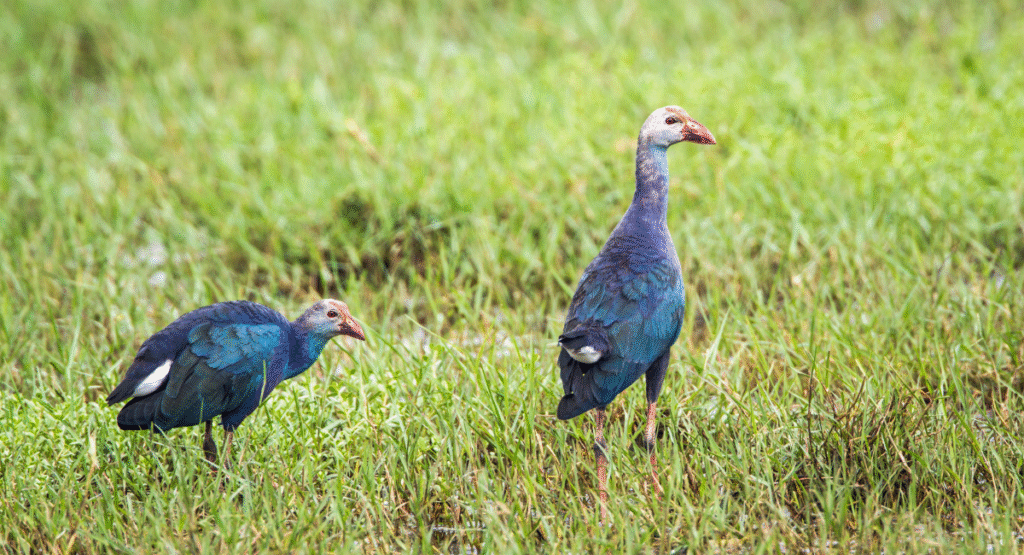
Planning Your Trip: Optimal Timing and Access Routes
Effective planning is paramount to securing the best possible wildlife encounters at a conservationally sensitive location like Bundala National Park. Timing, transport, and daily schedule require precise organization.
Best Time to Visit: Targeting the Avian Peak
The ideal period for visiting Bundala is intrinsically linked to the migration patterns of its waterfowl. The six-month window from September to March is consistently identified as the peak season, coinciding with the massive influx of migratory species, including the Greater Flamingo.
While the entire season offers exceptional viewing, the absolute sweet spot for maximizing diversity and population density is typically December. During this month, the convergence of arriving waders, waterfowl, and the large flamingo flocks ensures a spectacular photographic and observational experience.
The climate in Bundala is consistently hot and dry throughout the year, as the park lies within the Southeastern Arid Zone. However, the peak migratory season (Sep-Mar) offers the greatest rewards for serious birders.
Bundala National Park Seasonal Birding Guide
| Time of Year | Primary Bird Activity | Key Species to Spot | General Notes |
| September – March | Peak Migration Period | Greater Flamingo, Curlew Sandpipers, Greenshanks, Plovers | Highest diversity; optimal time for serious birdwatching. |
| October – December | Peak Wader Arrival | Broad-billed Sandpiper, Red-necked Phalarope (Rarer) | December is often considered the single best month for visitor experience. |
| April – August | Resident Species Only (Dry Season) | Pelicans, Herons, Storks, Kingfishers | Lower water levels can concentrate animals; flamingos are still possible due to the resident flock. |
Daily Safari Timing: Morning vs. Afternoon Trade-offs
A half-day safari is the standard format at Bundala, typically lasting three to four hours. The choice between morning and afternoon slots presents a strategic decision based on the visitor’s primary interest.
The Morning Safari: Birding Priority
For the avid birdwatcher, the early morning is non-negotiable. Birds are significantly more active during the cooler hours immediately following dawn, making this the best time for observation.
- Schedule: Morning safaris generally start between 5:00 AM and 6:00 AM, concluding around 9:00 AM or 10:00 AM.
- Optimal Entry: To maximize opportunities and secure a prime viewing position, tour operators recommend arriving at the park entrance as early as 4:00 AM (requiring a 3:30 AM hotel departure from Tissa). This early access often incurs an additional fee, typically a $25 USD surcharge for the entire jeep group, paid to the operator to arrange the pre-dawn entry. Paying this fee is highly recommended for those prioritizing the avian spectacle.
The Afternoon Safari: Mammal Potential
While birds remain active in the afternoon, often gathering around waterholes before settling down for the night, the later slot offers a slightly better chance of mammal sightings.
- Schedule: Afternoon safaris usually commence around 3:00 PM and conclude close to the park closing time at 6:00 PM.
- The Trade-Off: Though birding is rewarding in the afternoon, if mammal viewing (particularly elephants) is a higher priority than specialized wader sightings, the afternoon slot is more suitable, though park officials generally advise travelers seeking consistent elephant sightings to prioritize Udawalawe National Park.
How to Reach Bundala National Park (Access and Transport)
Bundala National Park is highly accessible, strategically located close to the major tourist hubs of the Southern Province.
- Primary Safari Hub: The town of Tissamaharama (Tissa) or nearby Kirinda serves as the most logical and convenient base for a safari. Bundala’s entrance is only 16.3 kilometers away from Tissamaharama, translating to an easy 30-minute drive.
- Strategic Proximity: For visitors already touring the South Coast, Bundala is easily reached: the drive from Tangalle is approximately 51 kilometers and takes about 55 minutes by car or taxi. This relatively short distance makes Bundala an accessible day trip without requiring extensive cross-country travel.
| Starting Point | Approximate Distance | Estimated Drive Time |
| Colombo | 244-252 km | 3 hours 35 minutes to 5 hours 40 minutes |
| Kandy | 244 km | 5 hours 40 minutes |
| Bentota | 185 km | 2 hours 42 minutes |
| Tangalle | 51 km | 55 minutes |
Transport Methods: Visitors can reach the area via public bus services or by hiring a chauffeur-driven or self-drive vehicle. However, it is essential to note that there is no railway near Bundala National Park, meaning train travel is not a feasible option for reaching the area directly. For international travelers, private tour packages including transportation from major hubs (e.g., Colombo starting from $60 USD per person, or Kandy starting from $40 USD per person) are available and often include tickets and refreshments.
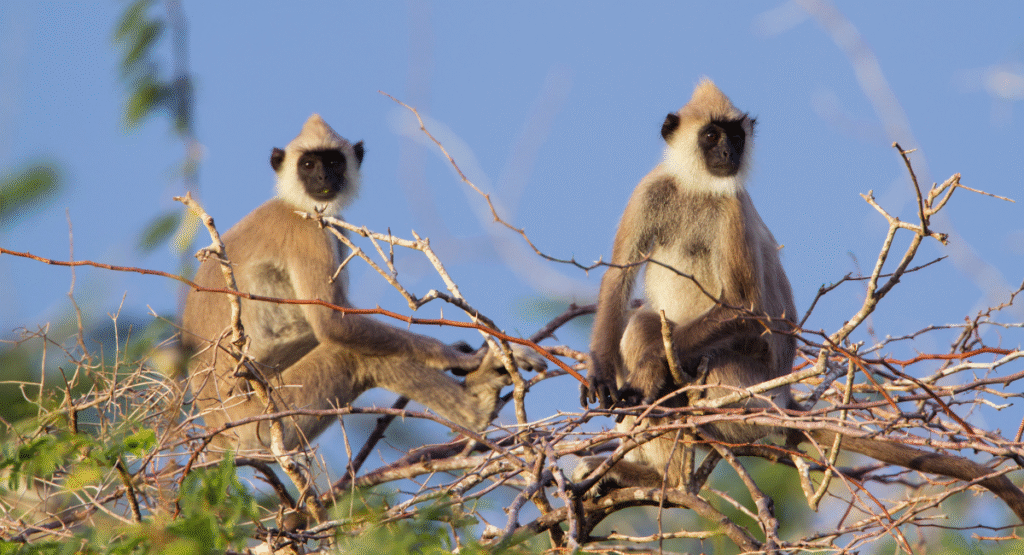
Cost Breakdown: Deconstructing Bundala Safari Expenses
One of the most common sources of confusion for visitors to Bundala is the wide, often contradictory range of quoted prices for park entry. Reported costs can fluctuate dramatically, ranging from a low of $12 USD up to $65 USD for a foreign adult. This section demystifies the structure of Bundala costs, providing necessary clarity for budgeting.
The significant price variation is a result of mixing three distinct cost components: the government entrance fee, mandatory taxes/service charges, and the privately hired jeep service.
The DWC Entrance Ticket Fee
Bundala is categorized as a Category 2 park by the Department of Wildlife Conservation (DWC). The following figures represent the core, government-mandated ticket price, exclusive of taxes, permits, and safari jeep hire:
- Foreign Adults: The base fee is consistently quoted by various sources between $12 USD and $16 USD.
- Foreign Children (Aged 6-12): The base fee is between $5 USD and $6 USD.
- Foreign SAARC Adults: Approximately $10 USD.
It must be understood that this fee is rarely the final amount paid at the gate, as taxes, government permits, and other mandatory fees must be layered on top. This accumulated ticket and tax amount often totals closer to $35 USD per foreign adult before the jeep is added.
Mandatory Safari Jeep Hire and Packaging
A safari jeep is mandatory for all visitors, as the park’s fragile ecosystem can only be traversed by guided vehicle. This is typically the most variable component of the total expenditure.
The majority of high-end quotes, such as the $65 USD or 63 EUR price point , do not represent the ticket fee alone. These figures invariably constitute an
all-inclusive package that bundles the DWC entrance ticket, mandatory government taxes, the half-day jeep hire, and often the services of a professional naturalist guide, sometimes including hotel transport and refreshments. While convenient, this pricing model obscures the individual cost of the government ticket.
For budget-conscious travelers, understanding the fixed cost of the jeep hire is critical for optimization. A half-day jeep hire starts at approximately $40 USD for the entire vehicle.
Budgeting Optimization and Expense Management
To maximize travel funds, visitors should always request an itemized breakdown of costs from potential operators. This crucial step allows the traveler to clearly differentiate the government ticket fee from the operator’s markup for services, transport, and guide expertise.
The fixed cost structure of the jeep hire provides a significant opportunity for savings:
- Sharing the Cost: The price per person drops dramatically as more seats in the jeep (maximum seven per vehicle) are filled. A solo traveler might pay up to $150 USD for a half-day package, but a party of two might pay $94 USD per person, and a larger group significantly less.
- Actionable Advice: Solo travelers or couples staying in Tissamaharama or Kirinda should proactively attempt to group up with other visitors to split the non-negotiable jeep hire cost, turning an expensive private tour into a highly affordable shared experience.
Bundala National Park Estimated Foreign Visitor Cost Breakdown (USD, 2024/2025)
| Cost Component | Estimated Price Range (Per Adult) | Notes |
| DWC Entrance Ticket Fee (Base) | $12 – $16 | Per-person cost based on sharing a vehicle, starting around $40 total. |
| Total Ticket Price including Taxes/VAT | $16 – $35 | Required layered government fees (highly variable). |
| Mandatory Jeep Hire (Half-Day, Shared 4+ Pax) | $15 – $30 | Per-person cost based on sharing a vehicle starting around $40 total. |
| All-Inclusive Half-Day Package Estimate | $45 – $75 | Includes ticket, taxes, jeep, and guide service; variable by group size and services. |
| Early Entry Surcharge (Total per Jeep) | $25 USD (Flat Fee) | Applicable if seeking pre-dawn access (start before 4:00 AM). |
Beyond the Birds: Mammals, Reptiles, and Terrestrial Ecosystem
While the avian life is the primary draw, ignoring the rest of Bundala’s biodiversity is a mistake. The dry scrubland and aquatic margins support a smaller, but highly unique, array of mammals and reptiles, reinforcing the importance of the UNESCO Biosphere Reserve status. The park hosts 32 animal species, offering a specialized experience for the observant visitor.
The Terrestrial Residents
Bundala protects a small resident herd of Asian elephants, whose numbers typically range between 25 and 60 individuals throughout the year. While sightings are possible, especially during the afternoon safaris when animals are drawn to water , Bundala is not marketed as a primary elephant viewing destination like Udawalawe National Park. Visitors can also spot wild buffalo, spotted deer, mongoose, and, occasionally, the elusive
For the dedicated enthusiast of specialized fauna, one of the most exciting potential sightings is the Sri Lankan fishing cat. This rarely-seen feline specializes in hunting along the wetland margins, providing an exciting chase for the sophisticated wildlife tracker. The presence of such niche, water-dependent mammals underlines the unique ecological balance Bundala maintains.
Reptilian Giants and Marine Conservation
The park’s lagoons and waterways are critical habitats for formidable reptilian life, hosting two major crocodile species:
- Estuarine (Saltwater) Crocodiles: These large reptiles are specialized for brackish and marine environments, often seen patrolling the deeper lagoon systems.
- Mugger Crocodiles: These freshwater specialists are more commonly found near the interior ponds and waterways.
The existence of both species within proximity is a testament to the diverse range of salinity and water types supported by the Bundala wetlands.
Furthermore, the park’s conservation value extends directly into the Indian Ocean. The coastal regions adjacent to Bundala serve as vital nesting grounds for four of Sri Lanka’s five marine turtle species: the Loggerhead, Green, Hawksbill, and Olive Ridley turtles. The protection offered to these coastal dunes and beaches demonstrates that the Ramsar designation is not confined merely to the inland lagoons but encompasses a complete, interdependent ecosystem spanning wetlands, scrubland, and the marine coast, essential for preserving multiple life forms.
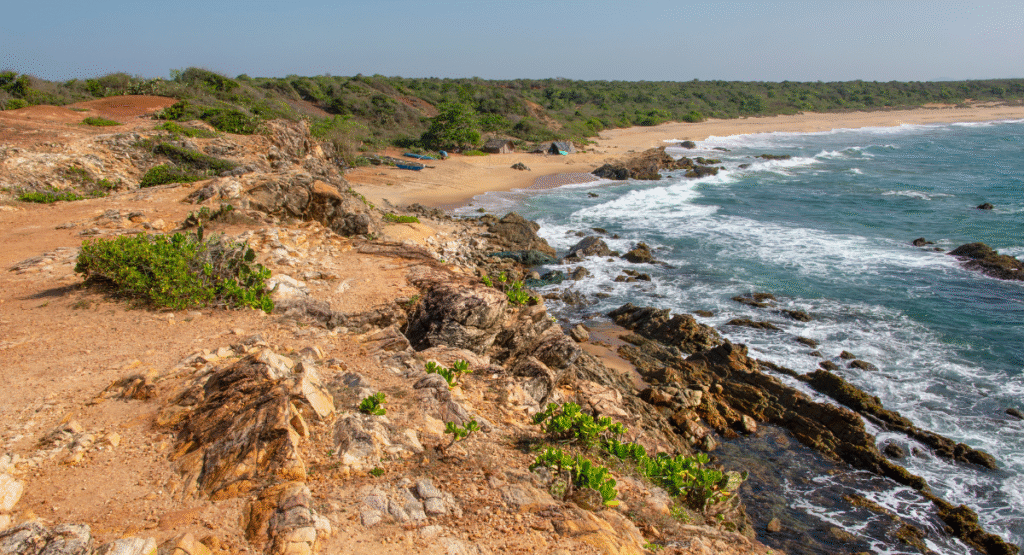
The Bundala Advantage: Why Choose Peace Over Leopards (Yala Comparison)
For travelers planning a Southern Sri Lankan safari, the decision often revolves around Yala, Udawalawe, or Bundala. While Yala National Park is famed for offering the highest density of leopards and Udawalawe guarantees large elephant herds, Bundala offers a distinct, high-quality value proposition: peaceful, specialized ecological immersion.
Bundala is a dedicated birding sanctuary. It is internationally recognized precisely because of its specialized, globally important wetland ecology and massive migratory bird population. This singular focus, combined with its lesser-known status, results in a superior safari experience for those who prioritize tranquility and authentic wildlife observation.
The Low-Crowd Experience: The Anti-Yala
The single greatest operational advantage Bundala holds over its famous neighbor, Yala, is the low visitation rate. Bundala is “much less visited than Yala,” which means visitors can enjoy wildlife encounters “without overflowing crowds”.
During peak season, Yala often faces intense congestion, with dozens of jeeps converging on key sightings. In contrast, Bundala’s peaceful atmosphere ensures a serene, authentic encounter with Sri Lanka’s natural beauty. For the discerning ecotourist who values quiet contemplation and high-quality observation over a checklist of common megafauna achieved amidst a traffic jam, Bundala presents itself as the indispensable alternative—the true destination for nature immersion.
The complexity of bird identification at Bundala, which involves spotting specific migratory waders like the rare Broad-billed Sandpiper, demands a specialized skill set. Therefore, the quality of the guide at Bundala is paramount. The focus shifts from merely tracking large mammals to locating subtle avian behaviors, making the naturalist guide an essential asset. Travelers should prioritize operators known for ornithological expertise to fully leverage the park’s unique offerings.
Practical Tips and Responsible Tourism for Your Bundala Safari
A Bundala safari requires specialized preparation to maximize the unique viewing opportunities presented by this Ramsar site.
Safari Essentials Checklist
Since bird identification is the central activity, the most crucial elements are optics and photography gear.
- Optics: High-quality binoculars are essential for identifying the vast array of waders and ducks. For serious birders, bringing a telescope or spotting scope is highly recommended for observing distant flocks, such as the Greater Flamingos feeding far across the lagoon. A Bundala safari without excellent magnification significantly diminishes the depth of the experience.
- Photography: A high-powered telephoto lens is necessary to capture the delicate details of the migratory species.
- Protection: Given that Bundala is situated in an arid zone with hot, dry conditions, travelers must carry adequate sun protection (sunscreen, hat, and light long-sleeve layers) and ensure they have sufficient water supplies for the 3-4 hour duration.
Booking Logistics and Gate Protocol
Jeep hire and guide services, particularly those specializing in birding, should be booked well in advance, especially during the peak migratory season (September to March). Tissamaharama remains the most convenient base for all logistics.
When confirming a booking, travelers must explicitly clarify the timing and whether the quoted fee includes the mandatory $25 USD early entry surcharge if they intend to arrive before dawn. This small fee is a worthy investment for guaranteed first access to the park, which is crucial for catching peak avian activity.
Responsible Tourism in a Ramsar Site
Visiting Bundala National Park comes with a responsibility to uphold the principles of conservation enshrined in its international designations. As a globally protected Ramsar Wetland and UNESCO Biosphere Reserve, the ecosystem is highly fragile. Visitors must:
- Adhere to Guide Instructions: Strict adherence to the guide’s instructions is required to minimize disturbance to fragile wetland habitats, especially nesting sites and waterbird feeding areas.
- Minimize Impact: Maintain a respectful distance from wildlife and avoid any sudden movements or loud noises that could flush birds or disturb mammals.
- Zero Waste: All personal waste must be collected and removed from the park premises, ensuring the integrity of the ecosystem remains uncompromised.
Conclusion: Securing Your Essential Sri Lankan Wildlife Encounter
Bundala National Park represents an indispensable facet of Sri Lanka’s natural heritage. Its status as the island’s first Ramsar site and a UNESCO Biosphere Reserve confirms its international significance, specifically as a critical wintering ground for migratory waterfowl. The park’s unique blend of wetlands, dunes, and scrubland supports a staggering 200 bird species, culminating in the spectacular sight of over 1,000 Greater Flamingos during the peak season.
Choosing Bundala National Park is a conscious decision to prioritize high-quality, specialized wildlife observation over mass-market thrills. It is the destination for those seeking the quiet thrill of specialized birding, the peaceful immersion of an uncrowded safari, and a deeper appreciation for the complex ecology required to sustain life, traveling from as far as Siberia.
To ensure the most rewarding experience, travelers must plan for the peak season (September to March), invest in specialized optics, secure an early morning safari slot, and strategically manage costs by seeking out itemized breakdowns and sharing jeep expenses. Bundala is not merely a place to visit; it is an essential site to protect, offering a profound connection to the global migratory ecosystem that few other destinations can match.

